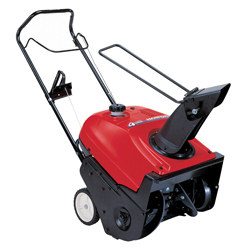 Honda Power Equipment has a reputation for providing the homeowner with exceptional machines that improve the snow blowing experience. The HS50 is no exception. The HS50 single-cylinder engine displaces 200 cubic centimeters and puts out 5 horsepower at 1,800 revolutions per minute driving models on wheels or tracks. Fuel tank capacity is 3.5 liters (0.92 gallons), enough for more than two hours of continuous operation. Maximum snow-blowing distance is nearly 40 feet, and snow-clearing capacity is more than 20 tons per hour. Continue reading
Honda Power Equipment has a reputation for providing the homeowner with exceptional machines that improve the snow blowing experience. The HS50 is no exception. The HS50 single-cylinder engine displaces 200 cubic centimeters and puts out 5 horsepower at 1,800 revolutions per minute driving models on wheels or tracks. Fuel tank capacity is 3.5 liters (0.92 gallons), enough for more than two hours of continuous operation. Maximum snow-blowing distance is nearly 40 feet, and snow-clearing capacity is more than 20 tons per hour. Continue reading
Category Archives: Uncategorized
Honda HS521 Snowthrower Maintenance
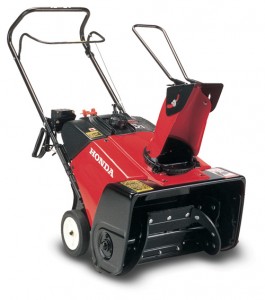 Like any great piece of power equipment, Honda’s HS521 snowthrower must be carefully maintained during the winter months to ensure that it functions perfectly each time there’s a bit of snow to clear. The equipment requires regular oil changes, spark plug checks and much more, as described in the included instruction manual. For those homeowners who are new to the HS521 or to snowthrower in general, there are a few key pieces of information to keep in mind as maintenance proceeds throughout the coldest months of the year. Continue reading
Like any great piece of power equipment, Honda’s HS521 snowthrower must be carefully maintained during the winter months to ensure that it functions perfectly each time there’s a bit of snow to clear. The equipment requires regular oil changes, spark plug checks and much more, as described in the included instruction manual. For those homeowners who are new to the HS521 or to snowthrower in general, there are a few key pieces of information to keep in mind as maintenance proceeds throughout the coldest months of the year. Continue reading
Getting Started with Your Honda HS621 Snowthrower
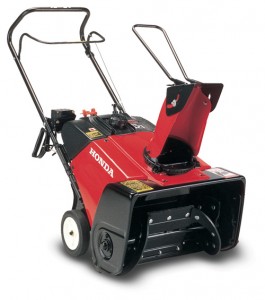 Honda’s snowthrowers are the best way to quickly clean up after a major winter storm, but learning how to use these powerful pieces of equipment can be a challenge for novice homeowners. Customers who are starting to learn about the controls and features of their HS621 snowthrower from Honda can benefit by reviewing a few basic tips concerning ignition, operation, and pre-operation checks before heading out on the snow and ice to clear away wintry precipitation. Continue reading
Honda’s snowthrowers are the best way to quickly clean up after a major winter storm, but learning how to use these powerful pieces of equipment can be a challenge for novice homeowners. Customers who are starting to learn about the controls and features of their HS621 snowthrower from Honda can benefit by reviewing a few basic tips concerning ignition, operation, and pre-operation checks before heading out on the snow and ice to clear away wintry precipitation. Continue reading
How to Troubleshoot Your Honda HS720 Snow Thrower
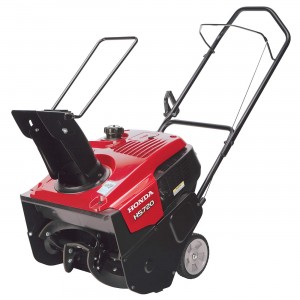 The Honda HS720 snowblower features durable materials and a dependable design geared toward the typical homeowner, but that doesn’t mean the equipment is immune from some common problems and troubleshooting headaches. Whether it’s due to a bit of required maintenance or a mere operator oversight, common problems include a nonfunctioning electric starter, snow discharge issues, and problems with the snowblower’s auger. Though these problems are certainly frustrating, they’re typically easy to diagnose and resolve either at home or with the help of an authorized Honda service technician. Before assuming the worst, review the most common issues facing HS720 snowblower owners and the resolutions to each problem. Continue reading
The Honda HS720 snowblower features durable materials and a dependable design geared toward the typical homeowner, but that doesn’t mean the equipment is immune from some common problems and troubleshooting headaches. Whether it’s due to a bit of required maintenance or a mere operator oversight, common problems include a nonfunctioning electric starter, snow discharge issues, and problems with the snowblower’s auger. Though these problems are certainly frustrating, they’re typically easy to diagnose and resolve either at home or with the help of an authorized Honda service technician. Before assuming the worst, review the most common issues facing HS720 snowblower owners and the resolutions to each problem. Continue reading
Transport and Storage Tips for Honda HRR216
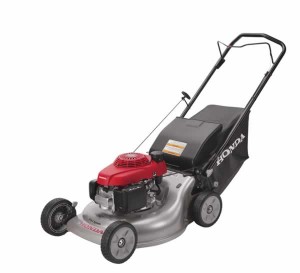 When autumn replaces summer’s hot temperatures and lawn maintenance with cooler days and outdoor cleanup, it’s likely time to prepare the lawn mower for extended storage until spring. This process is absolutely essential for ensuring the long-term durability and performance of the mower, since it protects the exterior surfaces, the blades, the engine, and other key parts. Whether it’s a bit of pre-storage cleaning, or some basic preventative maintenance before the mower is placed in its semi-permanent resting place for the winter, each of these recommendations will help to prevent corrosion and damage, ensure an easier time in the spring, and reduce the number of maintenance headaches over the long-term. Continue reading
When autumn replaces summer’s hot temperatures and lawn maintenance with cooler days and outdoor cleanup, it’s likely time to prepare the lawn mower for extended storage until spring. This process is absolutely essential for ensuring the long-term durability and performance of the mower, since it protects the exterior surfaces, the blades, the engine, and other key parts. Whether it’s a bit of pre-storage cleaning, or some basic preventative maintenance before the mower is placed in its semi-permanent resting place for the winter, each of these recommendations will help to prevent corrosion and damage, ensure an easier time in the spring, and reduce the number of maintenance headaches over the long-term. Continue reading
Winter Prep Guide for Honda HS720 Series Snow Throwers
 As homeowners prepare their lawn mower for storage and break out the leaf blowers, there is at least one other piece of equipment that needs to be ready for colder days ahead: the snowblower. The season’s first major snowfall can pop up without much notice, and will typically require pretty intensive cleanup around the home’s walkways and driveways. A properly serviced snowblower is the best way to welcome this first wintry event and to be prepared for all of the snow that’s sure to fall in the weeks and months to come. From oil changes to spark plug testing, auger, scraper, and other key parts, homeowners should cover the basics of pre-season maintenance before putting their snowblower to work for the first time this winter. Continue reading
As homeowners prepare their lawn mower for storage and break out the leaf blowers, there is at least one other piece of equipment that needs to be ready for colder days ahead: the snowblower. The season’s first major snowfall can pop up without much notice, and will typically require pretty intensive cleanup around the home’s walkways and driveways. A properly serviced snowblower is the best way to welcome this first wintry event and to be prepared for all of the snow that’s sure to fall in the weeks and months to come. From oil changes to spark plug testing, auger, scraper, and other key parts, homeowners should cover the basics of pre-season maintenance before putting their snowblower to work for the first time this winter. Continue reading
HRR216 Troubleshooting Guide
 Though they’re among the most durable push mowers on the market, Honda’s mowers do sometimes suffer from a few technical hurdles that need to be resolved before, during, or after mowing. These common problems are usually pretty easy to fix, sometimes with a quick adjustment or a replacement part. Before assuming the worst and calling a local service center for repair services, be sure to review the most common mower problems and the easiest ways to resolve them at home. Continue reading
Though they’re among the most durable push mowers on the market, Honda’s mowers do sometimes suffer from a few technical hurdles that need to be resolved before, during, or after mowing. These common problems are usually pretty easy to fix, sometimes with a quick adjustment or a replacement part. Before assuming the worst and calling a local service center for repair services, be sure to review the most common mower problems and the easiest ways to resolve them at home. Continue reading
How to Service Your Honda HRR216 Push Mower
 Getting acquainted with the Honda HRR216 push mower not only means mastering its controls, but also mastering the maintenance requirements that will keep the equipment in great condition for years, or even decades, to come. Proper maintenance ensures that the engine is running smoothly and efficiently, and it allows things like the grass bag and filters to be in excellent condition throughout the year so that any mowing performed looks professional and precise. Here’s what new mower owners need to know about HRR216 maintenance. Continue reading
Getting acquainted with the Honda HRR216 push mower not only means mastering its controls, but also mastering the maintenance requirements that will keep the equipment in great condition for years, or even decades, to come. Proper maintenance ensures that the engine is running smoothly and efficiently, and it allows things like the grass bag and filters to be in excellent condition throughout the year so that any mowing performed looks professional and precise. Here’s what new mower owners need to know about HRR216 maintenance. Continue reading
Honda HRR216 Operation Guide
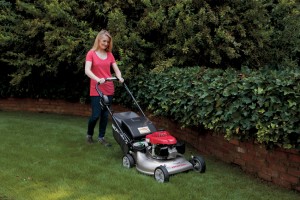 The key to maximizing a mower’s features and longevity is to understand exactly how the equipment works and how to properly operate it around the home. Because every mower is different, even those homeowners who aren’t new to mowing could probably benefit from a few tips, tricks, and helpful steps for their new Honda HRR216 lawn mower. Before getting started, consider these basic ways of operating and handling the mower on the turf and in other areas outside. Continue reading
The key to maximizing a mower’s features and longevity is to understand exactly how the equipment works and how to properly operate it around the home. Because every mower is different, even those homeowners who aren’t new to mowing could probably benefit from a few tips, tricks, and helpful steps for their new Honda HRR216 lawn mower. Before getting started, consider these basic ways of operating and handling the mower on the turf and in other areas outside. Continue reading
Getting Started with Your Honda HRR216
 Mower The Honda HRR216 mower is a powerful new way to keep the home’s outdoor spaces perfectly maintained and looking as if they were cared for by a professional. As with all new pieces of power equipment, however, this impressive Honda mower requires proper setup, a bit of safety guidance, and requires operators to have a bit of basic operational knowledge before they safely use the mower for the first time. Before getting started, here’s what to know. Continue reading
Mower The Honda HRR216 mower is a powerful new way to keep the home’s outdoor spaces perfectly maintained and looking as if they were cared for by a professional. As with all new pieces of power equipment, however, this impressive Honda mower requires proper setup, a bit of safety guidance, and requires operators to have a bit of basic operational knowledge before they safely use the mower for the first time. Before getting started, here’s what to know. Continue reading
